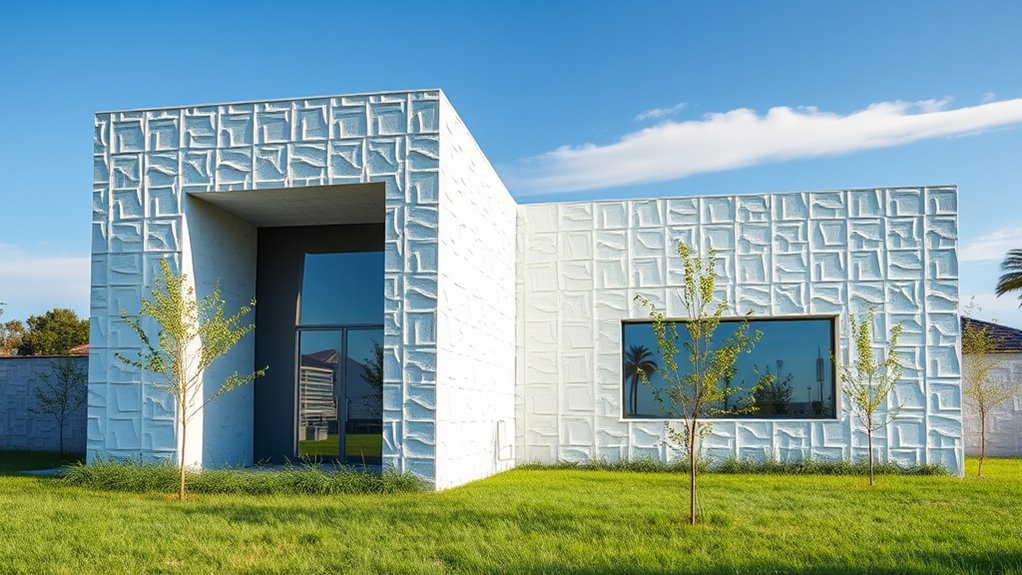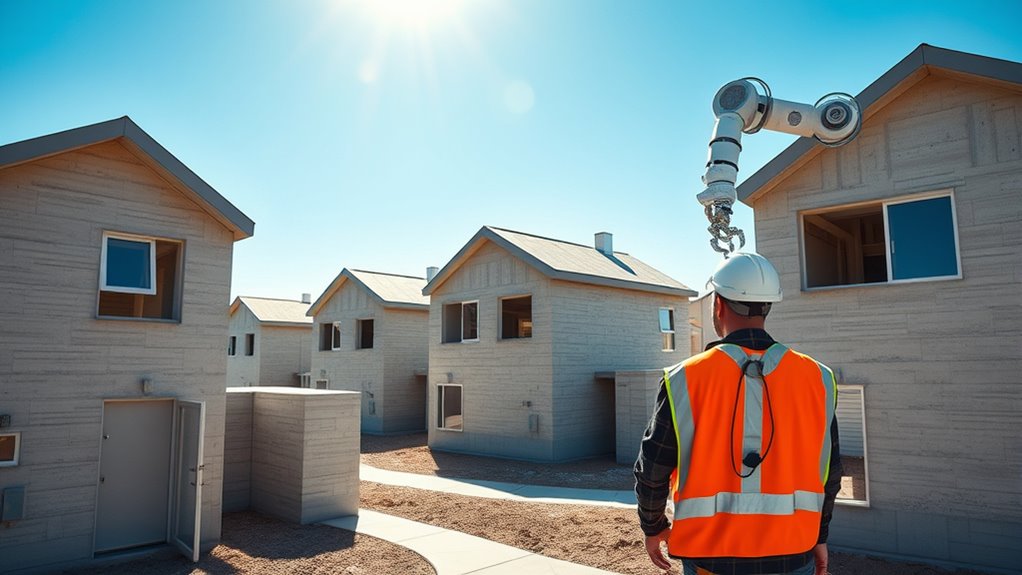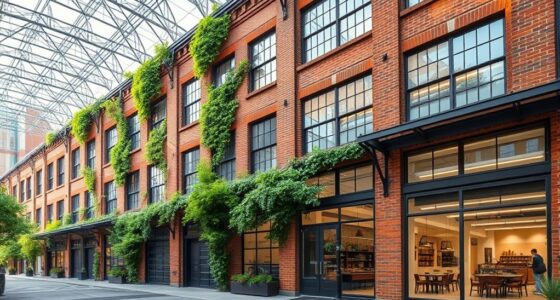You can now see how 3D printing offers fast, cost-effective, and eco-friendly ways to build sustainable homes. With rapid construction times and flexible material options, this technology makes affordable and customized housing more accessible, especially in disaster-prone or underserved areas. While challenges like regulations and scaling exist, ongoing advancements are promising for widespread adoption. Keep exploring to discover how close we are to transforming housing with the push of a button.
Key Takeaways
- 3D printing accelerates construction, enabling rapid, cost-effective, and customizable sustainable housing solutions.
- Eco-friendly materials like recycled plastics and bio-composites are increasingly used, promoting environmental sustainability.
- Technological advancements improve scalability, quality, and accessibility of 3D-printed homes worldwide.
- Regulatory challenges and material limitations currently hinder widespread adoption of 3D-printed sustainable houses.
- Continued innovation suggests 3D printing will play a significant role in future affordable, sustainable housing development.

Have you ever wondered how 3D printing is transforming the housing industry? It’s like stepping into a future where building a home becomes faster, more affordable, and potentially more sustainable. This technology is a prime example of construction innovation, pushing the boundaries of traditional building methods. Instead of lengthy construction timelines and hefty material waste, 3D printing allows you to create structures layer by layer, directly from digital blueprints. This process not only speeds up the construction cycle but also reduces the need for excess materials, leading to a significant environmental impact. By minimizing waste and optimizing resource use, 3D-printed homes could drastically lower the carbon footprint associated with traditional building practices.
3D printing is revolutionizing housing by enabling faster, more sustainable, and cost-effective construction methods.
The environmental impact of 3D printing in housing isn’t just about reducing waste. It also opens the door for using eco-friendly materials, such as recycled plastics, bio-based composites, or locally sourced substances. This flexibility means you could see homes built with sustainable materials that are better for the planet and your health. Plus, the precision of 3D printing helps ensure that structures are built with minimal errors, reducing the need for costly repairs or modifications later on. As a result, 3D-printed homes have the potential to be not only greener but also more durable and energy-efficient, thanks to the precise placement of insulation and other materials.
From a practical standpoint, this technology can revolutionize how you think about housing accessibility. Imagine being able to print a home in a matter of days or even hours, rather than months. This rapid construction capability could be a game-changer in disaster-stricken areas or regions facing housing shortages. It also makes it possible to customize designs easily, giving you the chance to tailor homes to specific needs or preferences without significant cost increases. The affordability of 3D printing could help bridge the gap between housing supply and demand, making sustainable homes more accessible to a broader population. Additionally, advancements in 3D printing technology continue to improve the quality and scale of these structures, paving the way for wider adoption.
While there are still hurdles to overcome—such as regulatory challenges, material limitations, and scaling issues—the momentum behind 3D-printed homes is undeniable. As technology advances, it’s likely you’ll see more widespread adoption of this innovative approach. The promise of sustainable, affordable, and quickly constructed houses at the push of a button isn’t just a distant dream anymore; it’s becoming a tangible reality that could reshape how we think about building and living in the future.
Frequently Asked Questions
What Are the Long-Term Durability Prospects of 3d-Printed Homes?
You might wonder about the long-term durability of 3D-printed homes, especially regarding material degradation and structural integrity over time. While early studies show promising results, questions remain about how these materials hold up against weather, wear, and aging. With ongoing research and advancements in printing technology, you can expect these homes to become more durable, but it is crucial to monitor their performance for long-term sustainability.
How Do 3d-Printed Houses Compare in Cost to Traditional Construction?
Did you know 3D-printed homes can reduce construction costs by up to 50%? When you compare the cost of 3D-printed houses to traditional building methods, you’ll find they often require less labor and materials, making budget considerations easier. This innovative approach can profoundly lower expenses, helping you save money while still achieving durable, sustainable housing. It’s a game-changer in affordable housing solutions for many communities.
Are There Any Health Risks Associated With 3D Printing Building Materials?
You might wonder about health risks from 3D printing building materials. Material toxicity is a concern, especially if fumes or particles are released during printing. Poor air quality can pose respiratory issues or skin irritation. To stay safe, guarantee proper ventilation and use non-toxic, eco-friendly materials. Regular monitoring and adherence to safety standards help minimize risks, making 3D-printed homes safer for everyone involved.
How Scalable Is 3D Printing Technology for Mass Housing Projects?
Imagine building a house with a giant 3D printer like a giant cake decorator—impressive but challenging. Scalability challenges and material limitations impact mass housing projects, as current printers struggle with size and speed. While some companies have printed entire homes quickly, widespread adoption faces hurdles. You need to overcome these issues before 3D printing can truly revolutionize affordable, large-scale housing.
What Regulatory Approvals Are Needed for 3d-Printed Residential Buildings?
When you want to build a 3D-printed home, you need to navigate building codes and zoning regulations first. These rules ensure safety, quality, and compliance with local standards. You’ll likely need to get approvals from local authorities, demonstrate how your project meets code requirements, and possibly adapt your plans to zoning laws. Staying informed about evolving regulations is key to smoothly gaining approval for your innovative building project.
Conclusion
Imagine a future where building a home is as simple as pressing a button—like turning on a light. 3D-printed homes hold the promise of revolutionizing sustainable living, making houses faster, cheaper, and greener. While challenges remain, the potential is as vast as an open sky. With technology advancing so quickly, it’s clear we’re on the cusp of turning this innovative dream into reality—building a greener world, one print at a time.










